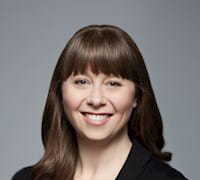The COVID-19 pandemic upended the way we work, turning our kitchen tables into home offices and forcing our dependence on Zoom. And unfortunately, women were hit the hardest as the public-health crisis ratcheted up existing social and economic tensions.
“The pandemic was particularly hard for women,” says Jane L. Risen, the H.G.B. Alexander Professor of Behavioral Science and a John E. Jeuck Faculty Fellow. She teaches a class on organizational diversity, and notes a few contributing factors. “Partly it was that the industries hit hardest were the ones women tended to be in, especially women of color. And women are typically the ones taking on caregiving responsibilities at home. So especially when schools closed, it was women who picked up that slack.”
As Risen spelled out, the pandemic’s impact on employed women was disproportionate because they typically perform caregiving duties in addition to their jobs, acting as the “household CEO” and doing more invisible labor at home than male counterparts (a data point confirmed by household surveys over the years). Many working mothers took on more childcare responsibilities, reduced work hours, or left jobs in response to pandemic pressures. As of September 2022, this trend has reversed, and the number of working-age women in the job market has returned to pre-COVID levels—but the preexisting disparities remain.
Suzanne El-Moursi, ’12 (XP-81), is cofounder and COO of BrightHive, a company that helps organizations securely link their data to empower decision-making and increase equality. As a mother of three whose husband is a frontline health-care worker, flexibility was a necessity.
“I cannot start my day before 10 a.m.,” El-Moursi says. “I need the first two hours to do things for my kids. I would say to friends, ‘You guys are so lucky. You have your husband at home working from a laptop.’ The pandemic shined a light on how much of a load women are carrying.”

“Women are typically the ones taking on caregiving responsibilities at home. So especially when schools closed, it was women who picked up that slack.”
— Professor Jane L. Risen
Even before the pandemic, stressed-out women workers were considering switching jobs due to increased burnout compared with their peers. A pre-COVID Harvard Business Review study from 2018–19 that surveyed US-based MBA graduates working full time asked how often the respondents experienced burnout and how much work negatively impacted their health. The data showed that many more women than men (and even more women of color) experienced burnout and poor health due to work. Long before the Great Resignation, 20 percent of millennial white women and women of color reported that their mental health was negatively influenced by work often or very often.
More recently, the 2022 McKinsey Women in the Workplace report—the largest study of women in corporate America—noted that women leaders are switching jobs at the highest rates ever seen (10.5 percent in 2021 compared with 6 percent in 2018). McKinsey calls this a “Great Breakup” as women are demanding more from work and leaving companies in never-before-seen numbers to get it.
Translation? With women already severely underrepresented in leadership—according to McKinsey, only one in four C-suite leaders is a woman, and one in 20 is a woman of color—companies are now struggling to hold onto their few women leaders. If they don’t act, they’ll lose not only current leaders but also the next generation, as young women are placing an even higher priority on flexibility, well-being, and diversity, equity, and inclusion at work.
Keeping the Positives
So what positive aspects of pandemic mode can we carry into the future of work for women? According to McKinsey, the overwhelming answer is flexibility and remote options. Only one in 10 women wants to work mostly on-site, and many say that remote/hybrid options are their top reasons for joining or staying with an organization.
Carol Winfrey, ’90, says that women are drawn to remote and flex time because they often have less linear careers than men due to child care and family considerations. “It used to be just: graduate and move up the pipeline. But a lot of times having kids comes at the same time as the lack of flexibility that accompanies career acceleration.” That led to fewer women being open to take on the top roles, she argues.
As chief growth officer of Athena Alliance, an executive development platform for women in senior leadership roles, Winfrey focuses on ensuring that through Athena’s network, education, and coaching platform, women have the skills, experience, and exposure needed to “swim in the fast lane,” to rise to and succeed at the highest levels in an organization.
“Women weren’t getting into those positions because there wasn’t recognition that you could have a nonlinear career path and still be ready for a senior role,” Winfrey says. “But now even LinkedIn has recognized that stay-at-home parenting is a thing we should show on CVs.”
Winfrey also notes something often overlooked in conversations about remote work—that double standards exist for men and women around what “professional” appearance entails. Working at home vastly reduces pressure to spend effort on the grooming and outfit curation involved in “looking professional”—feminine, yet polished.

“Women weren’t getting into those positions because there wasn’t recognition that you could have a nonlinear career path and still be ready for a senior role.”
— Carol Winfrey, ’90
“Even if you’re fast, in-person work means you’re going to spend an hour or two getting ready and commuting to the office. That is a significant amount of time on a daily and weekly basis,” Winfrey says. “Remote work lessens the need for all that. Instead, you can get a run in and still look presentable for an early meeting on Zoom.” El-Moursi hopes that a breakdown of those double standards can also allow the workforce to be more accepting of feminine presentation as legitimate in the workplace.
Working from home also empowers people with mobility challenges, autoimmune conditions, neurodiversity, mental illness, or pain management conditions by offering them more control over their environment. And, while most women endure common workplace microaggressions—and women of color often experience discrimination and prejudice as well—working from home can allow some distance from these stressors.
Winfrey believes working from home helps colleagues see one another’s humanity. “We’re seeing each other without makeup, hair in ponytails. We’re seeing each other’s spouses, kitchens, pets, and kids rather than conforming to a rigid workplace role built on the traditional model,” she says. There is also increased transparency and awareness around mental-health issues. “There are LinkedIn posts by CEOs who are vulnerable about depression or about having a child with challenges. You wouldn’t have seen that vulnerability three years ago.”
Visible Leadership
Given the benefits and drawbacks of women’s altered work lives during the pandemic, what can (and should) the future look like? Elena Siegel, ’10, is based in Dubai, United Arab Emirates, and works in social sustainability as a member of the UAE Global Council for Sustainable Development and a partner at leading global strategy consultancy Kearney.
Siegel works with companies and governments across industries to solve critical strategic issues. She notes that when you encourage companies to make public commitments around gender equality in a formal, government-driven way, they’re more likely to fully follow through. Encouraging this “has been a powerful tool the UAE has leveraged to advance gender equality and promote women into senior roles of influence,” Siegel says. “It’s one of the things they’re doing particularly well.”
Globally, there needs to be more effort put into getting women into senior, prominent roles, she argues. “You still have to create channels for women to move into positions of influence—board positions, speaker appointments, government roles. You have to find opportunities for women to rise without it simply being about quotas, because as we see in the research, quotas don’t work.” To actually advance women in the workplace, it will require more than just balancing the numbers.
“If you’ve never seen a woman CEO, you don’t understand women can be CEOs,” says Winfrey. “If you’ve never seen a woman of color in a leadership position, you don’t know it exists. When I joined Athena, one of the statistics that [founder and CEO] Coco Brown shared was, ‘There are 5,000 CEOs in San Francisco and only 250 women.’ It was like, ‘We have to change this.’”
First, Athena focused on helping women land board roles. “But,” Winfrey says, “we ran into, ‘There aren’t enough women who are board ready.’ Well, why is that? It’s because you need to have been in a C-suite. And then the boards would get into cultural fit, and cultural fit always seems to favor people just like you.”
It’s not all bad news, though, Winfrey says. “Women are still underrepresented, but we’re not zero.” Visibility is increasing—but there’s still a lot to do.

Wellness
Risen points out that in the years ahead, organizations may need to factor employee satisfaction differently as more people work from home. “It speaks to well-being,” she says. “If remote workers are just as productive as in-person workers, and simultaneously happier and more loyal, that’s a win, because organizations have struggled in recent years to keep engagement high,” she says.
El-Moursi thinks women must be willing to spell out what they need—but also, that organizations need to listen. BrightHive supports employees by allowing for paid time off that exceeds the Family and Medical Leave Act–mandated limit, implementing meeting-free “quiet hours” for the first and last four hours of the week, and offering unlimited PTO and vacation days.
If employees feel that their company isn’t flexible, its leadership needs to be asking them what they need to feel differently—and once they have a list of possibilities, they need to start making changes. “We need to see companies do things they’ve never done,” she says. When El-Moursi was at GE in 2007 in Finland, the office campus had saunas, and you could block time for a session on your calendar to keep the cold away. That’s the kind of energy El-Moursi wants companies to channel now.
“People will be blown away that you care enough about wellness that you’re going to integrate it into their day,” she says.
It’ll be important in the next few years to consider how to take the extra step to consider employee wellness—in all its forms.
“We also need to recognize that women of color and white women may experience work differently,” says Risen. “I’ve heard it said: if you want to know about your company culture, look at how women of color are treated. I think there is some real truth in that idea.”
And El-Moursi delves into a little-discussed aspect of the pandemic-era work shift: many people have seen their perspective on work and life be irrevocably altered. “What I’m seeing with friends—women or otherwise—is they’re saying, ‘I could be dead because of the pandemic. What am I doing with the time I have on earth?’” El-Moursi says. “They’re showing up for themselves differently. Work is not necessarily a first for people anymore: it’s self; it’s kids.
“We’re not our great-grandparents, who were just grateful for the paycheck.”
Managers and leadership have to be willing to acknowledge this shift. “In 2020, we would tell our BrightHive staff, ‘It’s family first.’ Now are the times that it gets tested,” says El-Moursi. “It’s a test of character as a manager: Do you really live by that?”

“What I’m seeing with friends—women or otherwise—is they’re saying, ‘I could be dead because of the pandemic. What am I doing with the time I have on earth?’ They're showing up for themselves differently.”
— Suzanne El-Moursi
Worries about Remote Work
Winfrey believes that flexible work needs to go next level. “Forward-looking companies are going to say, “What can be flexible?” At Athena, we have no offices. We’re totally remote. I have colleagues in different time zones. There are core hours, but they don’t necessarily need to be 8 a.m. to 6 p.m.,” Winfrey notes.
“Remote work and flexible work are here to stay,” says Risen. “These things help women, who tend to value flexibility more than men—because women are usually responsible for lots of the nonmarket work that has to get done.” While normalizing flexibility through remote work is crucial, the McKinsey study makes it clear that there are additional improvements needed to help women thrive.
Winfrey says one concern with remote work is the loss of informal mentorship. “I worry about those bonds,” she says. “How do we intentionally ensure these relationships develop? At Athena, we have peer learning circles and a path to the boardroom. We have, ‘Here’s a transition path. You’re on this with other people.’ We build that into our model.”
“Nine-to-five doesn’t exist anymore,” Siegel says. “But from the pandemic’s start, when everybody said the office is dead, I was like, ‘Y’all are crazy.’ I knew there was no way offices were never going to get used again. The kinds of internal networks and social interactions that you have in in-between spaces are part of what makes functioning organizations.”
Winfrey believes that for hybrid modes of working to operate and continue to help women succeed, companies need to be intentional and make sure they’re considering how remote work versus in-person work will factor into salary and promotions.
“If remote work becomes another fault line, it could end up being a problem for women,” Winfrey says. “Organizations must reevaluate their promotion and compensation processes to explicitly consider how they evaluate work, and ensure they’re doing it fairly regardless of where you’re sitting.”
Risen shares that concern. “If organizations reward in-person workers more than remote workers, or reward workers who work extremely long hours rather than workers with a limit on their time, then even if women are in the workforce, they probably won’t thrive,” she says.

Winfrey believes that we should also work on better communication. A flexible boss has been crucial to her own work life.
“I had a bad commute, three children, and a husband who was gone five days a week,” Winfrey says, “so flexibility was huge. I think the old idea of, ‘I have my eyes on my people and I’m going to make sure that they’re in their spot from Point A to Point B,’ those days are gone. Being a manager now requires different skills; you must be able to identify, ‘What are our goals and objectives? What do we need to do to get them?’ Get them doing it, and use communication and transparency.”
“If remote work becomes another fault line, it could end up being a problem for women."
— Carol Winfrey, ’90
Equality at Home
Siegel notes that gender equality at work cannot exist in a vacuum: equality at home matters too. “Women globally still carry the majority of the household load; that is a known fact,” Siegel says. “In the past several years, that burden of managing the household and the psychological well-being of the family has been a tremendous burden. It’s part of why we’ve seen burnout accelerate among working mothers and their exit from higher-profile positions; they simply don’t have the bandwidth to continue at that level.”
Risen agrees. “If mothers and fathers are equally responsible for caregiving, then they’re going to make use of work flexibility to a similar degree, and that will allow for more gender equality in the workplace,” she says. “But if it continues to be unbalanced at home, and if organizations don’t fairly compensate those who take advantage of flexibility, things are going to continue to be unequal.”
“If mothers and fathers are equally responsible for caregiving, then they’re going to make use of work flexibility to a similar degree, and that will allow for more gender equality in the workplace."
— Jane L. Risen
While Siegel recognizes that it’s difficult for companies to fix home dynamics, helping women carve out flexibility and space in their workday can help significantly. Winfrey agrees. “The more we recognize family commitments for men alongside women—paternity leave, men in leadership roles handling home responsibilities, more engagement by men in the “household CEO” role—the more that those roles will be shared,” Winfrey says. While the office used to be very structured, technologies have untethered us, which hopefully can also allow men to engage more in household roles.
Winfrey notes that approaches will vary depending on individuals’ situations—workers in retail and health care, after all, cannot benefit as much from remote or hybrid options—but says there’s still tremendous room for improvement. “Having the latitude to relax some of those things matters,” she says. Chipping away at practical biases can have big impact. “Women were once expected to be everything,” says Winfrey. “Give yourself a break!”
“Employers have to promote that the benefits that may be viewed as ‘helping working moms’ can and should be used by dads too,” adds El-Moursi. “Socializing the idea that dads can and should request childcare support and benefits will help extend the runway of help and caregiving, and ultimately benefit moms as well.”
A Change in Perspective
Generationally, careers are continuing to change. El-Moursi says that while our parents and grandparents were industrial, committing to one job or company for years, the information revolution ushered in something new. People moved around from job to job as new companies popped up and new information came to light. “You were trying to ensure you had employment that gave your family a better standard of living with every move you made,” she says. “Now we are in a new social revolution, and people—not just millennials, even myself, and I’m 44—are asking, ‘Is this the right job for me? Is this socially good?’”
The pandemic brought that generational shift home. “You’re seeing more freelancers,” says El-Moursi. “Being loyal to one place doesn’t work anymore. The pandemic helped us realize you have to put yourself first. That’s going to continue.”
Siegel agrees, pointing to her work at Kearney. “We’re turning our insights into actions through work that we do in the region,” she says. Two years ago, Kearney supported the UAE Gender Balance Council to develop a parental leave policy, making the UAE the first Arab country to grant parental leave to employees in both the public and private sector. Her industry is very demanding.
“We continue to struggle with retention and development of women, and have a lot of attrition at mid-tier levels,” she says. “But if we’re going to recommend things to our clients, we have to take care of our own house, so we’re internally looking at opportunities to give women more support and better advisory sponsorship from senior levels of the organization to assist their progression and development.” They’re looking to add more flexibility and help support women through the challenges of the business, she adds.

“If we’re going to recommend things to our clients, we have to take care of our own house, so we’re internally looking at opportunities to give women more support."
— Elena Siegel, ’10
Siegel personally experienced this flexibility. “I had a baby last year, came back from maternity leave, and had a conversation with senior partners where I said, ‘I really want to make this work, but I’m not sure how to do that.’ We agreed that I’d focus on a platform that didn’t require me to get on a plane every week,” she says. It worked best for Kearney and for her.
“I have seen this consistently across all regions where we’ve had people, not just women, return from leaves of absence and move into roles that allow them to continue flexing their consulting skills and contributing to the company without demanding that they do line consulting all the time,” Siegel says. “Those are the opportunities we need to make a normal part of the consulting path, so that we can continue to retain talent. I wouldn’t want to work anywhere else, because I’ve been tremendously well supported through the stages of life that I’ve gone through. That’s what you need to do in order to retain women long term.”


